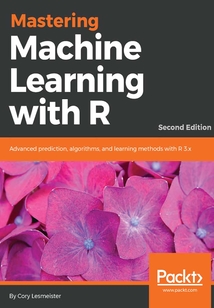首頁 > 計算機(jī)網(wǎng)絡(luò) >
數(shù)據(jù)庫
> Mastering Machine Learning with R(Second Edition)最新章節(jié)目錄
目錄(204章)
倒序
- 封面
- 版權(quán)信息
- Credits
- About the Author
- About the Reviewers
- Packt Upsell
- Customer Feedback
- Preface
- What this book covers
- What you need for this book
- Who this book is for
- Conventions
- Reader feedback
- Customer support
- Downloading the example code
- Downloading the color images of this book
- Errata
- Piracy
- Questions
- A Process for Success
- The process
- Business understanding
- Identifying the business objective
- Assessing the situation
- Determining the analytical goals
- Producing a project plan
- Data understanding
- Data preparation
- Modeling
- Evaluation
- Deployment
- Algorithm flowchart
- Summary
- Linear Regression - The Blocking and Tackling of Machine Learning
- Univariate linear regression
- Business understanding
- Multivariate linear regression
- Business understanding
- Data understanding and preparation
- Modeling and evaluation
- Other linear model considerations
- Qualitative features
- Interaction terms
- Summary
- Logistic Regression and Discriminant Analysis
- Classification methods and linear regression
- Logistic regression
- Business understanding
- Data understanding and preparation
- Modeling and evaluation
- The logistic regression model
- Logistic regression with cross-validation
- Discriminant analysis overview
- Discriminant analysis application
- Multivariate Adaptive Regression Splines (MARS)
- Model selection
- Summary
- Advanced Feature Selection in Linear Models
- Regularization in a nutshell
- Ridge regression
- LASSO
- Elastic net
- Business case
- Business understanding
- Data understanding and preparation
- Modeling and evaluation
- Best subsets
- Ridge regression
- LASSO
- Elastic net
- Cross-validation with glmnet
- Model selection
- Regularization and classification
- Logistic regression example
- Summary
- More Classification Techniques - K-Nearest Neighbors and Support Vector Machines
- K-nearest neighbors
- Support vector machines
- Business case
- Business understanding
- Data understanding and preparation
- Modeling and evaluation
- KNN modeling
- SVM modeling
- Model selection
- Feature selection for SVMs
- Summary
- Classification and Regression Trees
- An overview of the techniques
- Understanding the regression trees
- Classification trees
- Random forest
- Gradient boosting
- Business case
- Modeling and evaluation
- Regression tree
- Classification tree
- Random forest regression
- Random forest classification
- Extreme gradient boosting - classification
- Model selection
- Feature Selection with random forests
- Summary
- Neural Networks and Deep Learning
- Introduction to neural networks
- Deep learning a not-so-deep overview
- Deep learning resources and advanced methods
- Business understanding
- Data understanding and preparation
- Modeling and evaluation
- An example of deep learning
- H2O background
- Data upload to H2O
- Create train and test datasets
- Modeling
- Summary
- Cluster Analysis
- Hierarchical clustering
- Distance calculations
- K-means clustering
- Gower and partitioning around medoids
- Gower
- PAM
- Random forest
- Business understanding
- Data understanding and preparation
- Modeling and evaluation
- Hierarchical clustering
- K-means clustering
- Gower and PAM
- Random Forest and PAM
- Summary
- Principal Components Analysis
- An overview of the principal components
- Rotation
- Business understanding
- Data understanding and preparation
- Modeling and evaluation
- Component extraction
- Orthogonal rotation and interpretation
- Creating factor scores from the components
- Regression analysis
- Summary
- Market Basket Analysis Recommendation Engines and Sequential Analysis
- An overview of a market basket analysis
- Business understanding
- Data understanding and preparation
- Modeling and evaluation
- An overview of a recommendation engine
- User-based collaborative filtering
- Item-based collaborative filtering
- Singular value decomposition and principal components analysis
- Business understanding and recommendations
- Data understanding preparation and recommendations
- Modeling evaluation and recommendations
- Sequential data analysis
- Sequential analysis applied
- Summary
- Creating Ensembles and Multiclass Classification
- Ensembles
- Business and data understanding
- Modeling evaluation and selection
- Multiclass classification
- Business and data understanding
- Model evaluation and selection
- Random forest
- Ridge regression
- MLR's ensemble
- Summary
- Time Series and Causality
- Univariate time series analysis
- Understanding Granger causality
- Business understanding
- Data understanding and preparation
- Modeling and evaluation
- Univariate time series forecasting
- Examining the causality
- Linear regression
- Vector autoregression
- Summary
- Text Mining
- Text mining framework and methods
- Topic models
- Other quantitative analyses
- Business understanding
- Data understanding and preparation
- Modeling and evaluation
- Word frequency and topic models
- Additional quantitative analysis
- Summary
- R on the Cloud
- Creating an Amazon Web Services account
- Launch a virtual machine
- Start RStudio
- Summary
- R Fundamentals
- Getting R up-and-running
- Using R
- Data frames and matrices
- Creating summary statistics
- Installing and loading R packages
- Data manipulation with dplyr
- Summary
- Sources 更新時間:2021-07-09 18:24:30
推薦閱讀
- 在你身邊為你設(shè)計Ⅲ:騰訊服務(wù)設(shè)計思維與實(shí)戰(zhàn)
- Python絕技:運(yùn)用Python成為頂級數(shù)據(jù)工程師
- 復(fù)雜性思考:復(fù)雜性科學(xué)和計算模型(原書第2版)
- 卷積神經(jīng)網(wǎng)絡(luò)的Python實(shí)現(xiàn)
- 數(shù)據(jù)化網(wǎng)站運(yùn)營深度剖析
- Lean Mobile App Development
- 城市計算
- 數(shù)據(jù)驅(qū)動設(shè)計:A/B測試提升用戶體驗(yàn)
- Microsoft Power BI數(shù)據(jù)可視化與數(shù)據(jù)分析
- Oracle數(shù)據(jù)庫管理、開發(fā)與實(shí)踐
- 深入理解InfluxDB:時序數(shù)據(jù)庫詳解與實(shí)踐
- MySQL數(shù)據(jù)庫實(shí)用教程
- Arquillian Testing Guide
- Practical Convolutional Neural Networks
- 數(shù)字化轉(zhuǎn)型方法論:落地路徑與數(shù)據(jù)中臺
- 數(shù)據(jù)分析方法及應(yīng)用:基于SPSS和EXCEL環(huán)境
- C# 7 and .NET Core 2.0 High Performance
- R數(shù)據(jù)挖掘?qū)崙?zhàn)
- MySQL 8.0從入門到實(shí)戰(zhàn)
- 大數(shù)據(jù)處理框架Apache Spark設(shè)計與實(shí)現(xiàn)
- Mobile Application Penetration Testing
- 數(shù)據(jù)要素化時代的數(shù)據(jù)治理
- 循序漸進(jìn)Oracle:數(shù)據(jù)庫管理、優(yōu)化與備份恢復(fù)
- 數(shù)據(jù)質(zhì)量實(shí)踐手冊:4步構(gòu)建高質(zhì)量數(shù)據(jù)體系
- SQL必知必會(第4版)
- 架構(gòu)整潔之道
- 數(shù)據(jù)要素價值化藍(lán)圖:全景、認(rèn)知與路徑
- Creating Concrete5 Themes
- 高性能MySQL(第4版)
- 企業(yè)級數(shù)據(jù)架構(gòu):核心要素、架構(gòu)模型、數(shù)據(jù)管理與平臺搭建


